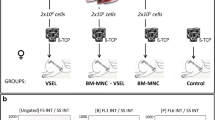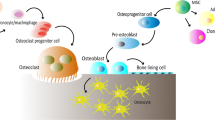Abstract
There is increasing interest in the therapeutic potential of stem cells because stem cells are promising candidates for the regeneration of tissue and treatment of diseases. Increasing evidence supports, multipotent stem cells may be obtained postnatally in different organs and tissues including bone marrow, synovium, adipose tissue, muscle and dental pulp. To determine a suitable cell source, the stem cells derived from periosteum and bone marrow of jaw bone(mandible) and long bone(tibia) were compared using rabbit models (JPO: periosteum from jaw-bone, JBM: bone marrow from jaw-bone, LPO: periosteum from long-bone, and LBM: bone marrow from long-bone). This study evaluated the proliferation and multilineage differentiation of the cells and clearly showed that expansion ability of JPO was higher than that of bone marrow derived cells. Comparisons of four different stem cells indicated that JPO group is the highest osteogenic potential. Moreover, this study has demonstrated that JPO, JBM and LBM are superior in terms of osteogensis and JPO, LPO and LBM are superior in terms of chondrogensis. Collectively, stem cells derived from jaw bone periosteium revealed highest osteogenic properties with relatively low morbidity with higher availability. Thus, it can be suggested that that periosteum from the jaw bone may be considered as optimal candidate for source of pluripotent stem cells with multi-germline potential with highest expansion ability and osteogenicity.
Similar content being viewed by others
References
JY Lim, AE Loiselle, JS Lee, et al., Optimizing the osteogenic potential of adult stem cells for skeletal regeneration, J Orthop Res, 29, 1627 (2011).
FJ Rodriguez-Lozano, C Bueno, CL Insausti, et al., Mesenchymal stem cells derived from dental tissues, Int Endod J, 44, 800 (2011).
I Sekiya, BL Larson, JR Smith, et al., Expansion of human adult stem cells from bone marrow stroma: conditions that maximize the yields of early progenitors and evaluate their quality, Stem Cells, 20, 530 (2002).
C De Bari, F Dell’Accio, P Tylzanowski, et al., Multipotent mesenchymal stem cells from adult human synovial membrane, Arthritis Rheum, 44, 1928 (2001).
SS Iyer, M Rojas, Anti-inflammatory effects of mesenchymal stem cells: novel concept for future therapies, Expert Opin Biol Ther, 8, 569 (2008).
H Yoshimura, T Muneta, A Nimura, et al., Comparison of rat mesenchymal stem cells derived from bone marrow, synovium, periosteum, adipose tissue, and muscle, Cell Tissue Res, 327, 449 (2007).
B Anne-Gaelle, S Samuel, B Julie, et al., Dental implant placement after mandibular reconstruction by microvascular free fibula flap: current knowledge and remaining questions, Oral Oncol, 47, 1099 (2011).
GM Raghoebar, HJ Meijer, K Stellingsma, et al., Addressing the atrophied mandible: a proposal for a treatment approach involving endosseous implants, Int J Oral Maxillofac Implants, 26, 607 (2011).
T Fukumoto, JW Sperling, A Sanyal, et al., Combined effects of insulin-like growth factor-1 and transforming growth factor-beta1 on periosteal mesenchymal cells during chondrogenesis in vitro, Osteoarthritis Cartilage, 11, 55 (2003).
JH Yun, JH Yoo, SH Choi, et al., Synergistic effect of bone marrow-derived mesenchymal stem cells and platelet-rich plasma on bone regeneration of calvarial defects in rabbits, Tissue Eng Regen Med, 9, 17 (2012).
A Cicconetti, B Sacchetti, A Bartoli, et al., Human maxillary tuberosity and jaw periosteum as sources of osteoprogenitor cells for tissue engineering, Oral Surg Oral Med Oral Pathol Oral Radiol Endod, 104, 618 e1 (2007).
K Ito, Y Yamada, S Nakamura, et al., Osteogenic potential of effective bone engineering using dental pulp stem cells, bone marrow stem cells, and periosteal cells for osseointegration of dental implants, Int J Oral Maxillofac Implants, 26, 947 (2011).
YS Jung, JH Jeong, S Yook, et al., Surface modification of pancreatic islets using heparin-DOPA conjugate and anti-CD154 mAb for the prolonged survival of intrahepatic transplanted islets in a xenograft model, Biomaterials, 33, 295 (2012).
T Iwata, M Yamato, Z Zhang, et al., Validation of human periodontal ligament-derived cells as a reliable source for cytotherapeutic use, J Clin Periodontol, 37, 1088 (2010).
Y Sakaguchi, I Sekiya, K Yagishita, et al., Comparison of human stem cells derived from various mesenchymal tissues: superiority of synovium as a cell source, Arthritis Rheum, 52, 2521 (2005).
AP de Souza Faloni, T Schoenmaker, A Azari, et al., Jaw and long bone marrows have a different osteoclastogenic potential, Calcif Tissue Int, 88, 63 (2011).
PA Zuk, M Zhu, P Ashjian, et al., Human adipose tissue is a source of multipotent stem cells, Mol Biol Cell, 13, 4279 (2002).
F Verdugo, K Simonian, A D’Addona, et al., Human bone repair after mandibular symphysis block harvesting: a clinical and tomographic study, J Periodontol, 81, 702 (2010).
FM Silva, AL Cortez, RW Moreira, et al., Complications of intraoral donor site for bone grafting prior to implant placement, Implant Dent, 15, 420 (2006).
HC Liu, LL E, DS Wang, et al., Reconstruction of alveolar bone defects using bone morphogenetic protein 2 mediated rabbit dental pulp stem cells seeded on nano-hydroxyapatite/collagen/poly(L-lactide), Tissue Eng Part A, 17, 2147 (2011).
JE Schroeder, R Mosheiff, Tissue engineering approaches for bone repair: concepts and evidence, Injury, 42, 609 (2011).
GF Rogers, AK Greene, Autogenous bone graft: basic science and clinical implications, J Craniofac Surg, 23, 323 (2012).
W Wang, Q Chen, X Li, et al., Enhancement of bone formation with a synthetic matrix containing bone morphogenetic protein-2 by the addition of calcium citrate, Knee Surg Sports Traumatol Arthrosc, (2012).
Author information
Authors and Affiliations
Corresponding author
Rights and permissions
About this article
Cite this article
Park, JB., Bae, SS., Lee, PW. et al. Comparison of stem cells derived from periosteum and bone marrow of jaw bone and long bone in rabbit models. Tissue Eng Regen Med 9, 224–230 (2012). https://doi.org/10.1007/s13770-012-0343-7
Received:
Revised:
Accepted:
Published:
Issue Date:
DOI: https://doi.org/10.1007/s13770-012-0343-7




